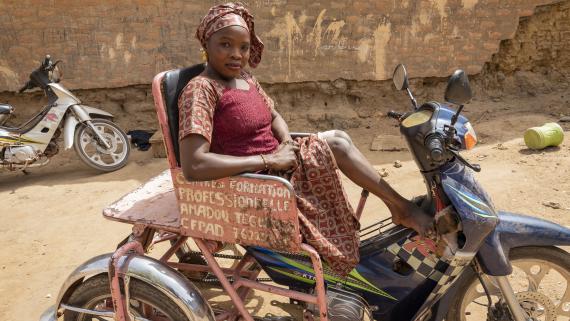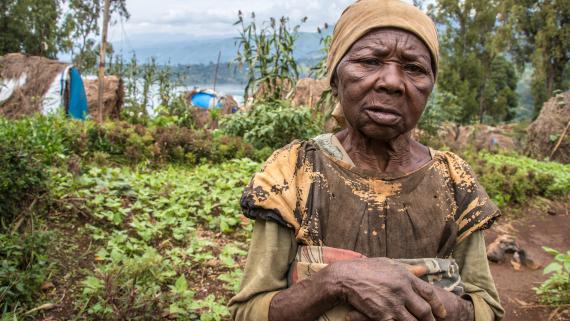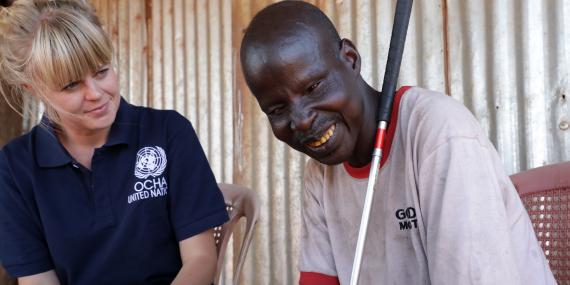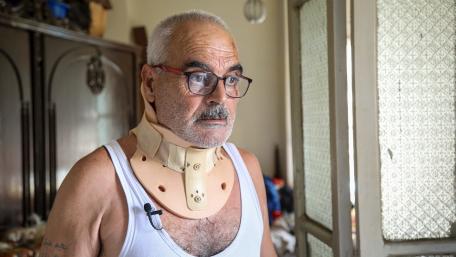Western Bahr el Ghazal, South Sudan.
This man is blind. He received training in walking independently with a cane provided by the NGO Sudan Evangelical Mission, with support from the South Sudan Humanitarian Fund. He no longer has rely on his daughter, who previously helped him walk, and she can go to school. In January 2020, OCHA South Sudan and partners assessed humanitarian needs in Wau and Jur River counties in Western Bahr el Ghazal, and monitored projects supported by the South Sudan Humanitarian Fund. OCHA/Anthony Burke OCHA/Anthony Burke
Fifteen percent of the world’s population has a disability, with 80 per cent living in developing countries. They also make up a much higher percentage of those in crisis-affected communities. The most marginalized, such as children with disabilities, are at higher risk of abuse and neglect, and women with disabilities are more likely to experience sexual violence.
At least 6.8 million IDPs – equivalent to 15 per cent of the global total for conflict-induced IDPs - could have a disability. As COVID-19 accelerated, strain increased on vital services supporting persons with disabilities, including access to information, psychological support, close personal care and treatment of underlying health conditions.
In conflict situations, the breakdown of economies and social networks, insecurity, destruction of infrastructure, displacement and closure of services due to the COVID-19 pandemic, take a significant toll on persons with disabilities. Environmental, institutional and attitudinal barriers increase the risks faced by of persons with disabilities experiencing poverty, abandonment or violence and hamper their access to basic services including health, water, sanitation and education. Discrimination based on age, gender, race, religion, ethnicity or membership of a minority group may compound these risks.

Sévaré, Mali
Around 60 disabled women have received support from UNDP for their income-generating activity, processing peanut seeds into peanut paste. UNDP supported them with a bathtub, two peanut grinders and a scale, which allowed them to increase their income.
UNDP/Aurélia RusekThe COVID-19 outbreak has laid bare and multiplied the disproportionate effects of humanitarian settings on persons with disabilities, with many experiencing unmet health needs: 22 countries have already reported a drop of more than 25 per cent coverage of disability support services since the onset of the pandemic. In Haiti, pre-existing stigmas and negative perceptions against persons with disabilities, including their perceived association with the pandemic, have led to increased discrimination and violence Humanitarian actors have, therefore, issued specific guidance for making response inclusive.
Good practices that emerged from the pandemic all pinpointed to a common factor: the importance of starting with an inclusive needs assessment. For example, in South Sudan, IOM consulted persons with disabilities in internally displaced and host community settings to design a more disability-inclusive approach to its response.
DRC: including the needs of persons with disabilities in humanitarian planning

The humanitarian community in DRC continues to strengthen the inclusion of persons with disabilities in the humanitarian programme cycle. An analysis of barriers encountered by persons with disabilities, carried out with 177 humanitarian partners, showed a lack of attention to the specific needs of this population group in humanitarian operations. It also revealed a lack of inclusive data and low participation of people affected in humanitarian action. Based on those observations, there was a series of recommendations and practical actions: The creation of a network of focal points to ensure inclusion in different sectors; Training of 363 humanitarian actors on disabilities and inclusion; Establishing focus groups with organizations of persons with disabilities; Mainstreaming their needs in analysis and response.
In 2021, efforts will continue through the development of inclusive sectoral strategies, action plans and tools, trainings and inclusive data-collection tools. Project proposals will be analysed to make them disability-inclusive. The participation of persons with disabilities in the technical support to operational actors will be encouraged, a joint handicap and age analysis will be carried out, and a knowledge, attitude and practice study will be undertaken.
OCHA/Eve SabbaghSimilarly, between March-April 2020, UNRWA community development social workers undertook a needs assessment among families of persons with disabilities. These families reported specific challenges associated with getting basic supplies of food, diapers, medicine, assistive devices and hygiene products during COVID-19. To address the identified needs, UNRWA provided home delivery of these important items directly to families.
The UN Secretary-General recommends the continued strengthening of capacities to mainstream the inclusion of persons with disabilities into strategies, policies and programming. He has also emphasised the importance of improving the collection, sharing and use of data on disability in disaster risk management and humanitarian programme cycles, encouraging the use of the IASC Guidelines on Inclusion of Persons with Disabilities in Humanitarian Action.
Further reading
Source: UN General Assembly
Source: United Nations
References
- WHO and World Bank, World report on disability, 2016
- UNICEF, Including children with disabilities in humanitarian action – General Guidance, 2017
- UN, Persons with disabilities in the context of internal displacement - Report of the Special Rapporteur on the Human Rights of Internally Displaced Persons (A/HRC/44/41), 15 June 2020
- For example, the Special Rapporteur on the rights of IDPs highlights in her report about persons with disabilities in displacement situations (A/HRC/44/41) that persons with disabilities are often not considered equal members of the community and are segregated in social gatherings. She also states her concern about reports of negative stereotypes and the stigmatization of internally displaced persons with disabilities, including by service providers, camp residents and host communities (https://undocs.org/A/HRC/44/41, page 14).
- IASC, Guidelines on Inclusion of persons with disabilitiesin humanitarian action, Octobre 2019
- UN, Persons with disabilities in the context of internal displacement - Report of the Special Rapporteur on the Human Rights of Internally Displaced Persons (A/HRC/44/41), 15 June 2020
- OCHA, Global Humanitarian Response Plan for COVID-19, July 2020
- Humanity & Inclusion COVID-19 in humanitarian contexts: no excuses to leave persons with disabilities behind! Evidence from HI's operations in humanitarian settings, 25 June 2020
- Syria Protection Cluster, A disability-inclusive COVID-19 response – brief guidance note, 9 April 2020 and IASC, COVID-19 resources relating to accountability and inclusion
- IASC Inter-Agency Working Group on Disability-Inclusive COVID-19 Response and Recovery, COVID-19 Response in Humanitarian Settings: Examples of Good Practices for Including Persons with Disabilities, July 2020
- IASC, IASC Key messages on applying IASC Guidelines on Disability in the COVID-19 Response, 7 July 2020 and Report of the UN Secretary-General on Natural disasters.





